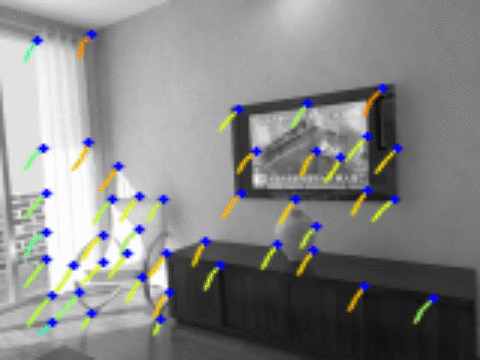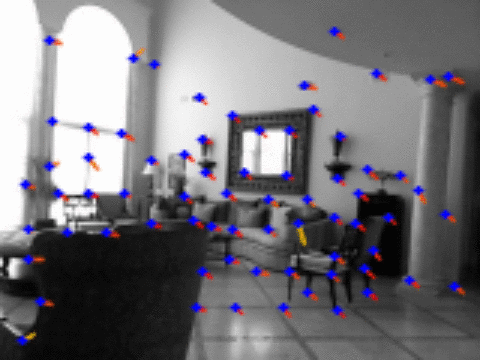This repo contains the pretrained SuperPoint network, as implemented by the originating authors. SuperPoint is a research project at Magic Leap. The SuperPoint network is a fully convolutional deep neural network trained to detect interest points and compute their accompanying descriptors. The detected points and descriptors can thus be used for various image-to-image matching tasks. For more details please see
-
Full paper PDF: SuperPoint: Self-Supervised Interest Point Detection and Description
-
Presentation PDF: Talk at CVPR Deep Learning for Visual SLAM Workshop 2018
-
Authors: Daniel DeTone, Tomasz Malisiewicz, Andrew Rabinovich
This demo showcases a simple sparse optical flow point tracker that uses SuperPoint to detect points and match them across video sequences. The repo contains two core files (1) a PyTorch weights file and (2) a python deployment script that defines the network, loads images and runs the pytorch weights file on them, creating a sparse optical flow visualization. Here are videos of the demo running on various publically available datsets:
This repo depends on a few standard pythonic modules, plus OpenCV and PyTorch. These commands usually work (tested on Mac and Ubuntu) for installing the two libraries:
pip install opencv-python
pip install torchThis demo will run the SuperPoint network on an image sequence and compute points and descriptors from the images, using a helper class called SuperPointFrontend. The tracks are formed by the PointTracker class which finds sequential pair-wise nearest neighbors using two-way matching of the points' descriptors. The demo script uses a helper class called VideoStreamer which can process inputs from three different input streams:
- A directory of images, such as .png or .jpg
- A video file, such as .mp4 or .avi
- A USB Webcam
./demo_superpoint.py assets/icl_snippet/You should see the following output from the ICL-NUIM sequence snippet:
./demo_superpoint.py assets/nyu_snippet.mp4 --cudaYou should see the following output from the NYU sequence snippet:
./demo_superpoint.py camera --camid=1./demo_superpoint.py assets/icl_snippet/ --W=640 --H=480 --no_display --write --write_dir=myoutput/- Use
--Hto change the input image height (default: 120). - Use
--Wto change the input image width (default: 160). - Use
--display_scaleto scale the output visualization image height and width (default: 2). - Use
--cudaflag to enable the GPU. - Use
--img_globto change the image file extension (default: *.png). - Use
--min_lengthto change the minimum track length (default: 2). - Use
--max_lengthto change the maximum track length (default: 5). - Use
--conf_threshto change the point confidence threshold (default: 0.015). - Use
--nn_threshto change the descriptor matching distance threshold (default: 0.7). - Use
--show_extrato show more computer vision outputs. - Press the
qkey to quit.
@inproceedings{detone17superpoint,
author = {Daniel DeTone and
Tomasz Malisiewicz and
Andrew Rabinovich},
title = {SuperPoint: Self-Supervised Interest Point Detection and Description},
booktitle = {CVPR Deep Learning for Visual SLAM Workshop},
year = {2017},
url = {http://arxiv.org/abs/1712.07629}
}- We do not intend to release the SuperPoint training or evaluation code, please do not email us to ask for it.
- We do not intend to release the Synthetic Shapes dataset used to bootstrap the SuperPoint training, please do not email us to ask for it.
- We use bi-linear interpolation rather than the bi-cubic interpolation described in the paper to sample the descriptor as it is faster and gave us similar results.
Install Miniconda
conda env create -f environment.yml
conda activate SuperPointPretrainedNetwork
jupyter notebook
Just launch SuperPointTesting.ipynb and follow the notebook.






